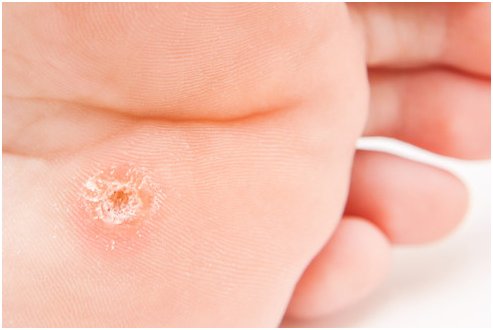
Skin warts are growths on the skin that are caused by a virus called human papillomavirus (HPV). HPV infection is common; there are different types, some of which can cause warts.
- Common warts (rough warts often found on the hands, knees, or other areas)
- Plantar warts (warts on the bottom of the feet)
- Flat warts (warts that appear as small, smooth bumps on the skin)
- Genital warts (warts in the genital area, also called “condyloma acuminatum”)
Who gets warts? — Common, plantar, and flat warts are most common in children and young adults. People with certain jobs, such as handling meat, fish, and poultry, may also be more likely to develop common warts. People who have chronic skin conditions, such as eczema, and people with a weakened immune system (e.g., from AIDS or after an organ transplant) may have more extensive warts or warts that are difficult to control.
How do you get warts? — People can become infected with the virus that causes warts (HPV) by touching another person’s wart. HPV is more likely to infect skin that is injured or softened by water, but they can infect healthy skin as well. It can take up to six months or longer after exposure to the virus for a wart to appear.
SKIN WART TREATMENT
Treatment of warts depends upon where the wart is located and how much it bothers you. Treatment is not necessary in all cases. For instance, two-thirds of skin warts in children will resolve on their own within two years, without treatment. However, during this time, the wart may enlarge or new warts may appear. In addition, a few small warts are usually easier to treat than multiple larger warts. For these reasons, most people choose to treat skin warts, particularly if they are painful, persistent, or bothersome in their appearance.
There are many ways to treat warts. Some treatments take several weeks or even months to work, and warts can come back after treatment. Plantar warts and periungual warts can be particularly difficult to eradicate with treatment.
People with diabetes may have a higher risk for complications from some wart treatments. If you have diabetes and have developed skin warts, it’s best to talk with your health care provider before trying any home treatments.
Treatment you can try at home
Salicylic acid — Salicylic acid is a type of acid that is applied directly to the wart. It comes in different forms, such as a liquid or patch.
If you decide to try salicylic acid treatment at home, you should follow the instructions on the package or your provider’s instructions. This often involves first soaking the wart in warm water for five minutes, then drying the skin completely, and then applying the salicylic acid. These steps are repeated each day. If the wart does not go away within 12 weeks, you should stop treatment and see your health care provider.
If you have neuropathy (nerve damage that causes numbness), you should not use salicylic acid, as it could injure your skin without you realizing it.
Treatments performed by a health care provider
Liquid nitrogen — Liquid nitrogen, often called “cryotherapy,” is a very cold liquid that destroys warts by freezing the skin. Liquid nitrogen must be applied by a health care provider, and multiple treatments are often needed to eliminate the wart.
Liquid nitrogen is often used to treat warts in older children and adults. The treatment can be difficult for younger children to tolerate because it can be painful.
After liquid nitrogen treatment, most people heal within four to seven days.
Liquid nitrogen can cause permanent loss of skin color in the areas treated. If you have concerns about how your skin will appear after treatment with liquid nitrogen, talk to your health care provider.
Cantharidin — Cantharidin is a liquid that is applied by a health care provider to treat skin warts. It may be particularly useful for young children because it causes no pain initially. However, some people develop pain, blisters, and swelling 2 to 24 hours after the treatment.
The skin usually heals within 5 to 10 days after treatment.
Shave excision — Shave excision is a procedure that involves removing a skin wart with a blade. A health care provider performs the procedure, usually after injecting local anesthesia to numb the skin.
Other treatments — Examples of other treatments that may be used for warts include 5-fluorouracil cream (sample brand name: Efudex), imiquimod cream (sample brand name: Aldara), and immunotherapy. A health care provider prescribes or performs these treatments. Immunotherapy involves the application or injection of a substance to the wart to trigger a response from your body’s immune (infection-fighting) system. These treatments are usually used for people with many warts or warts that do not respond to other treatments.
WHEN TO SEEK HELP
- You are not sure if you skin growth is a wart.
- Your skin wart does not improve with home treatment. A health care provider should examine it to confirm that it is not a skin cancer or another skin condition.
- You would like to use home treatment, but are not sure which treatment is right for you.
- You have a wart that is bleeding or growing rapidly.
- You have been treated for warts and have developed signs of a skin infection, such as redness, pain, or pus-like drainage from the treated area. In some cases, redness and pain are normal reactions after wart treatment, so discuss possible side effects with your health care provider in advance.
